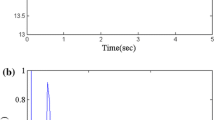Abstract
A new rotor broken bar fault diagnosis method for induction motors based on the double PQ transformation is presented. By distinguishing the different patterns of the PQ components in the PQ plane, the rotor broken bar fault can be detected. The magnitude of power component directly resulted from rotor fault is used as the fault indicator and the distance between the point of no-load condition and the center of the ellipse as its normalization value. Based on these, the fault severity factor which is completely independent of the inertia and load level is defined. Moreover, a method to reliably discriminate between rotor faults and periodic load fluctuation is presented. Experimental results from a 4 kW induction motor demonstrated the validity of the proposed method.
Similar content being viewed by others
References
Bellini, A., Filippetti, F., Franceschini, G., Tassoni, C., Kliman, G.B., 2001. Quantitative evaluation of induction motor broken bars by means of electrical signature analysis. IEEE Trans. on Ind. Appl., 37(5):1248–1255. [doi:10.1109/28.952499]
Bellini, A., Filippetti, F., Franceschini, G., Tassoni, C., Passaglia, R., Saottini, M., Tontini, G., Giovannini, M., Rossi, A., 2002. On-field experience with online diagnosis of large induction motors cage failures using MCSA. IEEE Trans. on Ind. Appl., 38(4):1045–1053. [doi:10.1109/TIA.2002.800591]
Bellini, A., Franceschini, G., Tassoni, C., 2006. Monitoring of induction machines by maximum covariance method for frequency tracking. IEEE Trans. on Ind. Appl., 42(1): 69–78. [doi:10.1109/TIA.2005.861320]
Cardoso, A.J.M., Saraiva, E.S., 1993. Computer-aided detection of airgap eccentricity in operating three-phase induction motors by park’s vector approach. IEEE Trans. on Ind. Appl., 29(5):897–901. [doi:10.1109/28.245712]
Cruz, S.M.A., Cardoso, A.J.M., 2000. Rotor cage fault diagnosis in three-phase induction motors by extended Park’s vector approach. Electric Machines and Power Systems, 28(3):289–299.
Cruz, S.M.A., Cardoso, A.J.M., Toliyat, H.A., 2003. Diagnosis of Stator, Rotor and Airgap Eccentricity Faults in Three-phase Induction Motors Based on the Multiple Reference Frames Theory. Conference Record of the 2003 IEEE Industry Applications Society Annual Meeting, p.1340–1346.
Cruz, S.M.A., Cardoso, A.J.M., 2004. Diagnosis of stator inter-turn short circuits in DTC induction motor drives. IEEE Trans. on Ind. Appl., 40(5):1349–1360. [doi:10.1109/TIA.2004.834012]
Cupertino, F., Vanna, E.D., Salvatore, L., Stasi, S., 2004. Analysis techniques for detection of IM broken rotor bars after supply disconnection. IEEE Trans. on Ind. Appl., 40(2):526–533. [doi:10.1109/TIA.2004.824432]
Filippetti, F., Franceschini, G., Tassoni, C., Vas, P., 1998. AI techniques in induction machines diagnosis including the speed ripple effect. IEEE Trans. on Ind. Appl., 34(1): 98–108. [doi:10.1109/28.658729]
Han, Y., Song, Y.H., 2003. Condition monitoring techniques for electrical equipment—a literature survey. IEEE Trans. on Power Deli., 18(1):4–13. [doi:10.1109/TPWRD.2002.801425]
Kliman, G.B., Koegl, R.A., Stein, J., Endicott, R.D., Madden, M.W., 1988. Noninvasive detection of broken rotor bars in operating induction motors. IEEE Trans. on Energy Conv., 3(4):873–879. [doi:10.1109/609364]
Lee, L.M., Lee, D.C., Seok, J.K., 2004. Control of series active power filters compensating for source voltage unbalance and current harmonics. IEEE Trans. on Ind. Electr., 51(1):132–139. [doi:10.1109/TIE.2003.822040]
Luis, A.P., Denis, F., Daniel, S.G., Libano, F.B., Sergio, H., 2006. Application of the Welch, Burg and MUSIC Methods to the Detection of Rotor Cage Faults of Induction Motors. Transmission & Distribution Conference and Exposition, p.1–6.
Marei, M.I., Abdel-Galil, T.K., El-Saadany, E.F., Salama, M.M.A., 2005. Hilbert transform based control algorithm of the DG interface for voltage flicker mitigation. IEEE Trans. on Power Deli., 20(2):1129–1133. [doi:10.1109/TPWRD.2004.843461]
Niu, F.L., Huang, J., Yang, J.Q., Chen, L.Y., Jin, H., 2005. Rotor broken-bar fault diagnosis of induction motor based on Hilbert-Huang transformation of the startup electromagnetic torque. Proc. CSEE, 25(11):107–112 (in Chinese).
Schoen, R.R., Habetler, T.G., 1995. Effects of time-varying loads on rotor fault detection in induction machines. IEEE Trans. on Ind. Appl., 31(4):900–906. [doi:10.1109/28.395302]
Schoen, R.R., Habetler, T.G., 1997. Evaluation and implementation of a system to eliminate arbitrary load effects in current-based monitoring of induction machines. IEEE Trans. on Ind. Appl., 33(6):1571–1577. [doi:10.1109/28.649970]
Author information
Authors and Affiliations
Corresponding author
Additional information
Project (No. 50677060) supported by the National Natural Science Foundation of China
Rights and permissions
About this article
Cite this article
Huang, J., Yang, Jq. & Niu, Fl. Rotor broken bar fault diagnosis for induction motors based on double PQ transformation. J. Zhejiang Univ. - Sci. A 8, 1320–1329 (2007). https://doi.org/10.1631/jzus.2007.A1320
Received:
Accepted:
Published:
Issue Date:
DOI: https://doi.org/10.1631/jzus.2007.A1320




